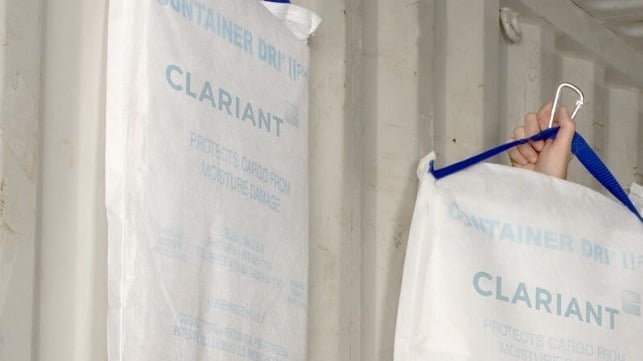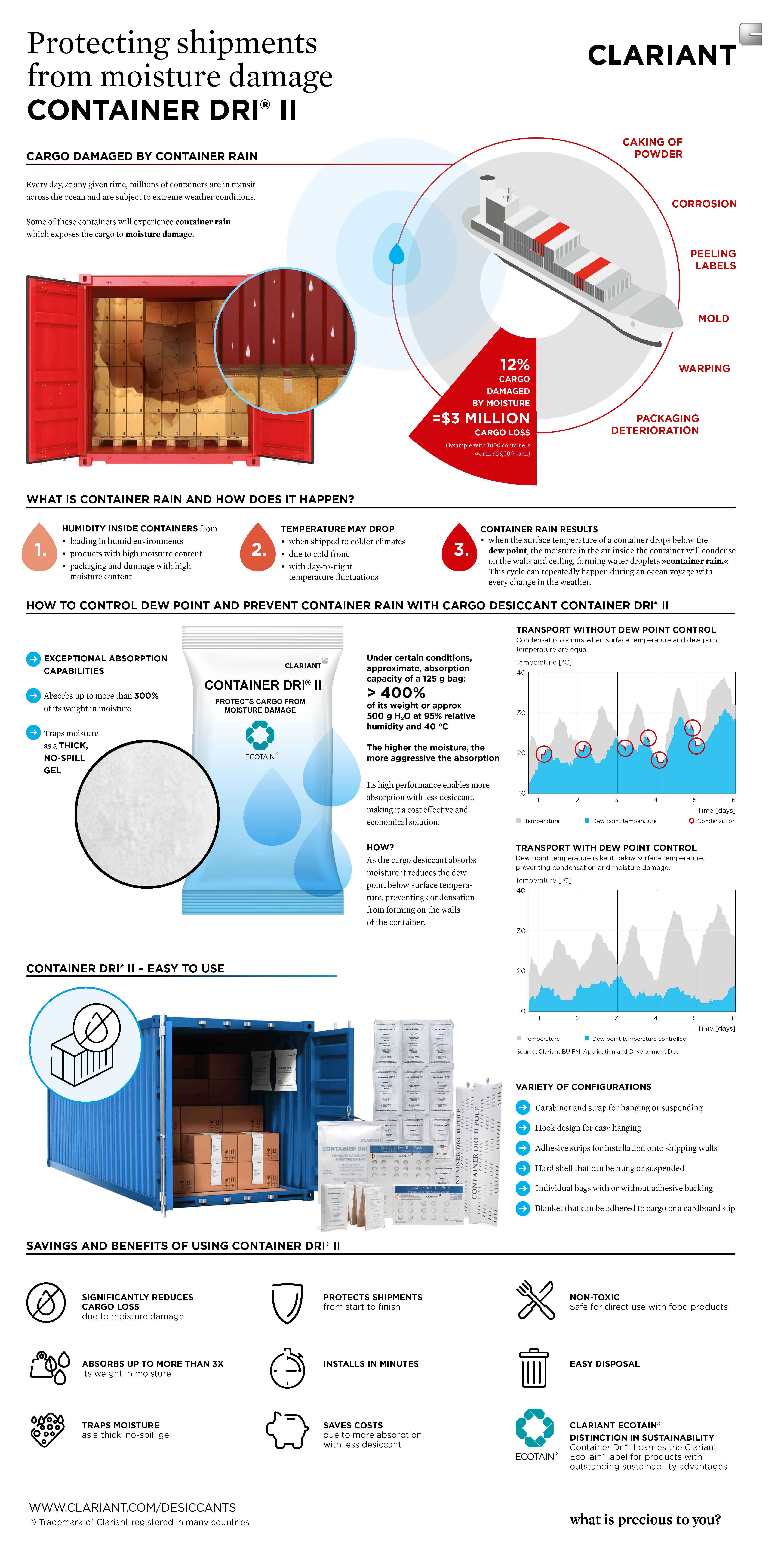Making Every Shipment Count With Cargo Protection Solutions
Minimize risks of damage, delay, or rejection by controlling moisture and VOCs

The resilience of the global supply chain has been tested as never before in 2021, as manufacturers, shippers, importers and customers struggle mightily to overcome pandemic-related disruptions and reestablish some semblance of normalcy. But, amid surging consumer demand, huge order backlogs, record levels of port congestion and delays, overstretched trucking resources, and rising shipment costs, it appears that “normalcy” and predictability in the supply chain are unlikely in the forseeable future.
Given this atmosphere of uncertainty, it is all the more important for manufacturers and shippers – and for the trading partners and merchants who pay for each shipment – to ensure that every container that reaches its destination yields a cargo of goods that are intact, undamaged, and ready for sale, use, or consumption.
For decades, Clariant Cargo & Device Protection has provided cost-efficient, easy-to-use products that protect containerized cargoes in their weeks-long or months-long journeys by ship, truck, and train throughout the world. Even within the confines of a sealed container, these cargoes face the prospect of damage, loss, or delays from two sources: excess moisture and the dangers of accumulated volatile organic compounds (VOCs).
Preventing Moisture Damage to Cargoes: Moisture, the residual humidity held in goods or commodities, packaging materials, pallets, wooden container floors, and even ambient air within sealed shipping containers, can pose a danger at virtually any time during weeks of intermodal land and sea transport. Relative humidity levels as low as 40% can trigger surface rust on metal products, while higher humidity levels (60-70% or greater) can support the growth of damaging molds, mildews, or other microorganisms on raw agricultural commodities, fabrics, or leather goods.
Should a rapid weather change trigger a drop of as little as 4.4 to 5.5° C (8 to 10° F) in temperature, the residual humidity within a container can condense rapidly into water droplets on the container’s ceiling, walls, and cargo. “Container rain” as it’s called, can soak raw agricultural commodities (grains, nuts, coffee beans, cocoa beans), metal products or machinery, cardboard packaging, fabric and leather goods, even consumer electronics. If repeated warm-cool weather cycles occur, the risk of damage intensifies as commodities, products, and packaging suffer the same damaging cycle of high humidity and droplet condensation again and again.
To minimize the risk of moisture-related cargo damage, shippers have come to rely on Container Dri® II cargo desiccants from Clariant Cargo & Device Protection. When attached in the form of bags, strips, or blankets inside cargo containers, this desiccant absorbs residual moisture and traps it in a thick, no-spill gel. Made from a non-toxic blend of high-purity calcium chloride and a special gelling agent, Container Dri II is able to absorb up to 300% or even more of its own weight in moisture. It is non-toxic, safe for use with food products, and disposable in ordinary trash. The continuous drying action of Container Dri II desiccant helps to maintain a low relative humidity in containers and cargoes, and, when used as recommended, can provide the long-term moisture protection that cargoes need today.
Minimizing VOC Risks and Delivery Delays: Other types of cargo can be subject to shipping delays or non-acceptance due to the presence of volatile organic compounds. VOCs are present in goods manufactured using polymers, adhesives, paints and coatings, solvents and other industrial products. After manufacturing, VOCs may “outgas” from new products such as shoes, carpeting, foam mattresses and cushions, furniture, toys and textiles. When these products are loaded and shipped in sealed cargo containers, VOCs can accumulate to significant levels. And if, upon arrival, a container is opened for inspection or unloading, the sudden release of accumulated VOCs can expose people to strong odors and inhalation-related health risks. Significant delays may occur if inspectors decide that VOC levels are too high and that the container must be “aired out” before its cargo can be inspected, transshipped, or handled. Should VOC levels or odors be judged unacceptable by merchants or customers, entire shipments or individual product packages may be rejected altogether.
Fortunately, there’s a new solution to help protect containerized cargoes – or individual product packages – from the risks of delay or rejection due to unpleasant VOC odors or harmful VOC concentrations: DESVOCANT™ VOC adsorber from Clariant CDP. Made from a naturally occurring, highly adsorbent form of bentonite clay, DESVOCANT attracts and adsorbs a range of VOCs, trapping them within the complex mineral structure of tiny clay granules. This unique and non-toxic product, which is available in sizes large enough for shipping containers and small enough for shoe boxes, adsorbs a wide range of VOCs, including:
- aromatic compounds including benzene, toluene, and xylene;
- aldehydes and ketones including formaldehyde, acetaldehyde, ethylbutylketone, and acetophenone;
- halogenated hydrocarbons including 1,2-dichloroethane, carbon tetrachloride, chlorobenzene, and 1,1,2,2,-tetrachloroethane;
- alcohols like methanol, ethyl and isopropyl alcohol; and,
- other compounds including esters/ethers, nitrogen- and sulphur-based materials.
One only needs to envision the armada of container ships riding at anchor outside the world’s major ports to realize that containers and their cargoes, like the people and ships that move them, are under more stress than ever. Dwell times of a week or more, on top of already extended ocean voyages, only extend the period during which problems like moisture or VOCs can damage or diminish cargo values. Times like this are why smart shipping executives have long relied on the efficacy of Container Dri II cargo desiccants and, more recently, on DESVOCANT VOC adsorbers, to help reduce the risks of cargo damage and bring more of the world’s goods safely into the hands of grateful – and waiting – customers.

that matters most
Get the latest maritime news delivered to your inbox daily.
Justin Mueller is Global Head of Business Group for Clariant Cargo & Device Protection.
This article is sponsored by Clariant. For more information, please visit www.clariant.com/desiccants.
The opinions expressed herein are the author's and not necessarily those of The Maritime Executive.

